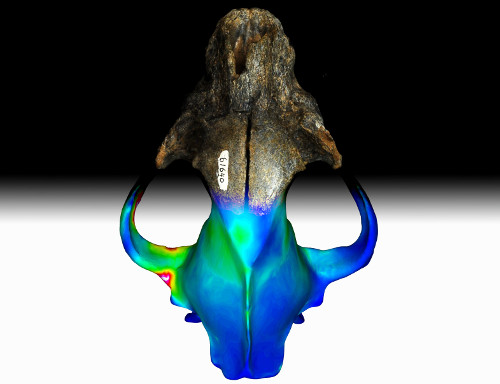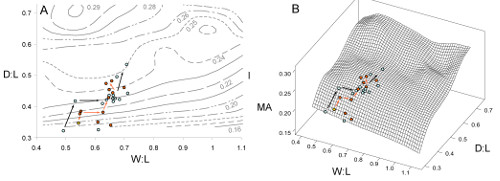Cracking the Code of Bone-Cracking Carnivores
Finite element analysis, or FEA, is a computer modeling technique that lets researchers simulate how structures “behave” under various conditions. For instance, you can check out how a car crumples in an impact, follow the flow of heat through a computer chip, or see the distribution of stress in a skull bone while an animal chews its food. Paleontologists utilize FEM to learn more about the function and evolution of skulls in extinct animals and their living relatives. It’s much easier than cloning a dinosaur and getting the legal and ethical approvals to run the necessary experiments! Another great thing is that computer models don’t have to be constrained by reality–you can tweak the skulls of real organisms into unreal configurations, to understand the biological principles constraining skull anatomy.

Paleontologist Zhijie Jack Tseng uses FEM to understand skull evolution in “extreme” bone-cracking carnivores. Today, we think of hyenas as the consummate bone-crackers. Their beefy skulls and massive teeth are perfect for getting to the tasty, nutritious center of a leg bone. Although hyenas superficially look like dogs, they’re actually more closely related to cats. Not to be outdone, though, some extinct dog species independently evolved very hyena-like skulls. Dr. Tseng is studying the skulls in both groups, to understand how their skulls work (wonderfully outlined in this video from the folks at Ph.D. Comics). Yesterday, he had a major new paper in PLOS ONE with some of his latest findings on the topic [full disclosure–I was the academic editor who handled this paper], and was kind enough to talk about it over email. Whether they’re dogs or more closely related to cats, these bone-crushers are fascinating critters!

Q: How would you describe this study and its findings?
A: This study tested the hypotheses that specialized bone-cracking hyenas and dogs evolved similar skulls that also had similar biting capabilities, and that the adaptations for bone-cracking are optimized from an engineering perspective. What I found, using models of theoretical skulls and those from actual species, was that increasingly specialized dogs and hyenas did evolve stronger and more efficient skulls, but those skulls are only optimal in a rather limited range of possible variations in form. This indicates there are other factors restricting skull shape diversity, even in lineages with highly directional evolution towards biomechanically-demanding lifestyles.
Q: What was the most surprising thing that you found out in your research here?
A: The most surprising thing to me was that, although the range of theoretical skull shapes I generated included forms that resemble real carnivore skulls, the actual distribution of carnivoran species in this theoretical space is quite restricted. It shows how seemingly plausible skull shapes nevertheless do not exist in nature (at least among the carnivores that I studied).
Q: You had some really cool plots of functional landscapes (see the example below)…what software did you use to make those figures?
A: I used the freely available program PAlaeontological STatistics (PAST) by Øyvind Hammer at the University of Oslo to generate the 2D contour plots, and the engineering statistics program Minitab to generate the 3D landscape plots. They were really fun to make.

Q: You did a lot of computer modeling for this paper, and you are making the files for these models available to the world via Dryad [it should be live shortly now live]. Aside from the notable efforts at Biomesh, it is often tough to find these sorts of data online (I’m certainly guilty in my own published work–AAF). What incentives or tools are needed to encourage broader sharing of these sorts of models by researchers? For what uses might you encourage other researchers to use your models?
A: To encourage more widespread use and sharing of these models, databases such as Biomesh go a long way in organizing the large amount of data generated from these types of studies. I hope to see inter-linked databases in the future, where specimens and their models can be searched through museum collection databases, CT databases (such as Digimorph), and model databases (e.g. Biomesh). Keeping track of this process from museum specimen to computer model can be daunting, if there is no infrastructure in place! The research community should also agree on one (or a few) common formats for sharing the models, preferably accessible using open-source programs, so the models can be viewed and used without the barrier set by software companies. I would love to see the models from this paper tested using additional scenarios and settings, to see how consistent the results from this paper really are. The models also can be converted to other formats for use in morphometrics research, etc.
To learn more, check out Dr. Tseng’s web page, his Ph.D. Comics video, or read his paper at PLOS ONE.
Citation: Tseng ZJ (2013) Testing adaptive hypotheses of convergence with functional landscapes: a case study of bone-cracking hypercarnivores. PLOS ONE 8(5): e65305. doi:10.1371/journal.pone.0065305
